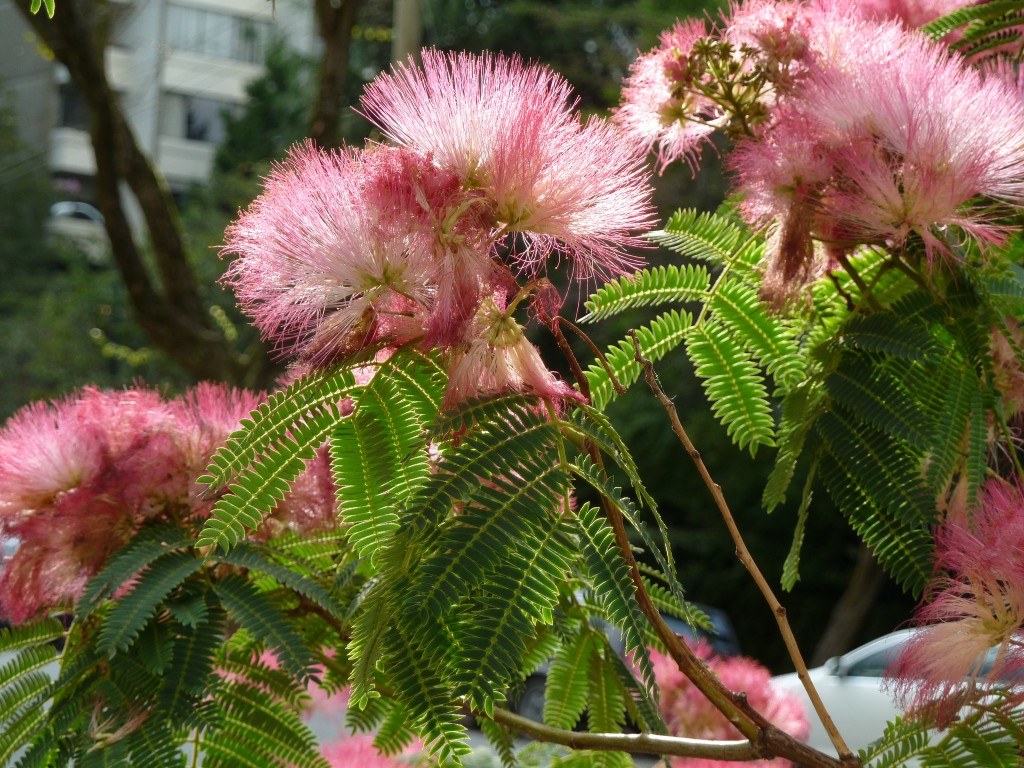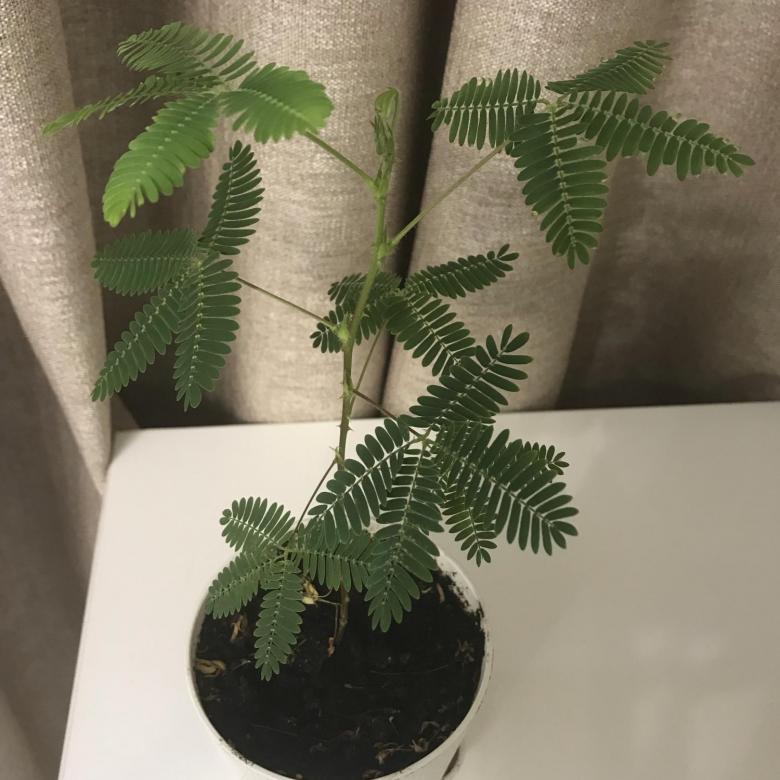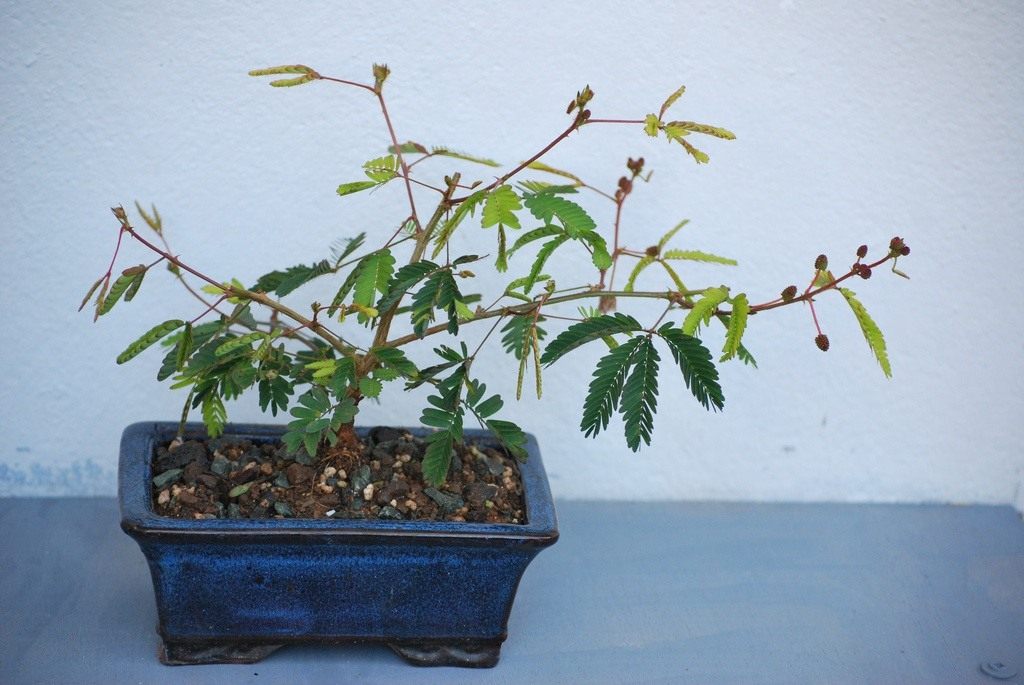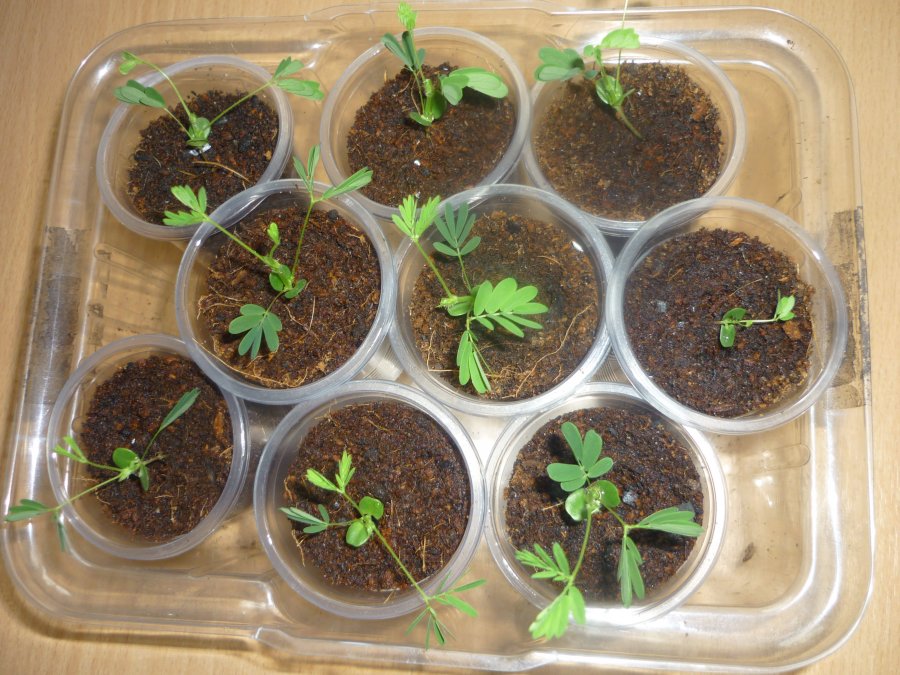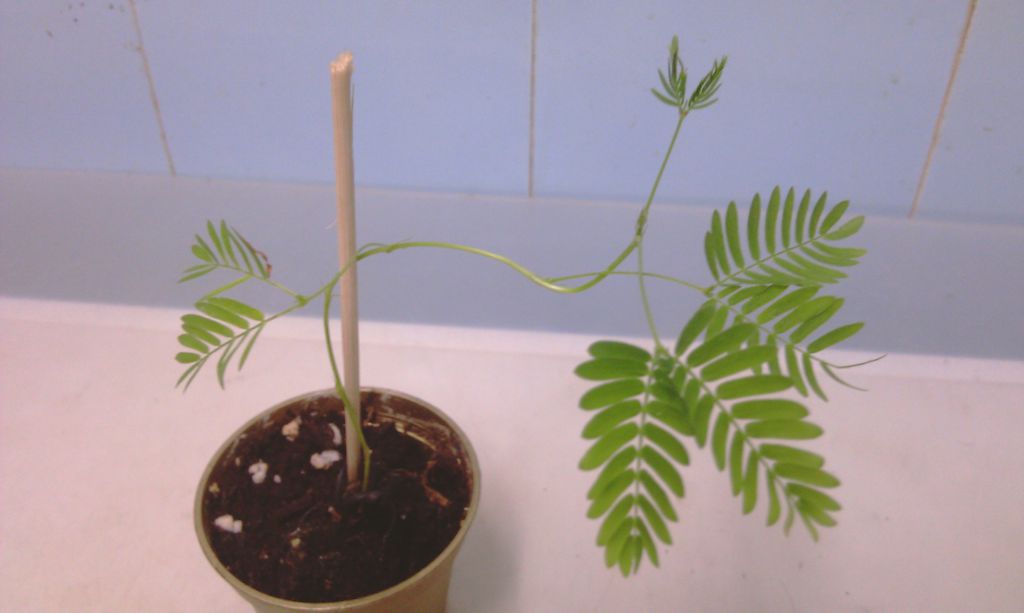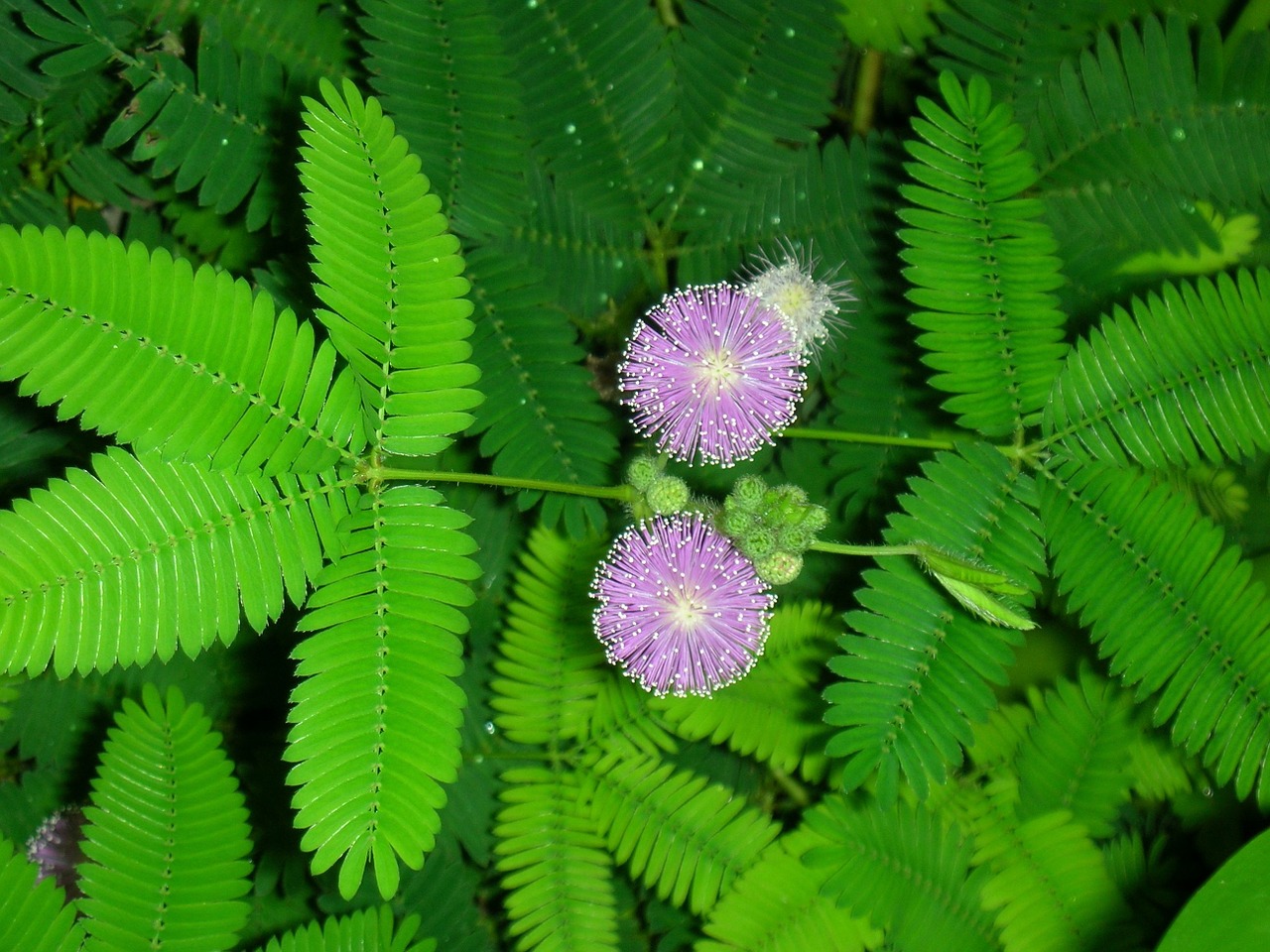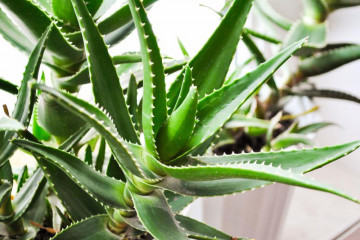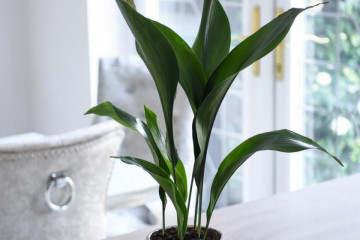Mimosa flower: growing conditions and plant care options
Content:
Mimosa is a common plant. Its thin green stems are strewn with small fluffy yellow lumps, carved light green feathery leaves with villi give a special tenderness to the flower.
Already at the beginning of spring it can be seen in flower shops. The flower is traditionally given to women on March 8th.
Main types
This plant has several varieties that look very different from each other.
The most common varieties are Bashful, Hostilis, and Yellow.
Mimosa bashful
It is a perennial medicinal and at the same time an ornamental herb. Shy mimosa has a reddish stem, an inflorescence in the form of a ball, its pink flowers resemble pompons. The flower has extremely sensitive leaves: when something touches them, they fold and fall. Leaves react in a similar way to sunset. This property creates the illusion that the plant is embarrassed, for which the variety got its name.
Mimosa Hostilis
The mimosa plant looks like a small tree with thorns on the trunk. Brazil is considered the birthplace of the variety. Its leaves are feathery, dissected. This variety blooms with white fragrant flowers. Mimosa blooms like a spikelet. It has long been known that this type of mimosa contains psychotropic substances.
Mimosa yellow
This variety is also known as “silver acacia”. Her homeland is Australia, where she begins to bloom as early as January. Mimosa looks like fluffy balls close together.
Home care
The culture is rarely grown in meadows, as the plant is poisonous. The most common home cultivar is mimosa pudica. Proper care of bashful mimosa at home is important.
Humidity
People who decide to start it at home need to remember that the birthplace of the flower is tropical forests, where the air humidity is very high. The main condition for growing at home is air humidity. The plant does not tolerate dry air and heat. It is recommended to spray the air regularly to maintain the humidity at 75-85%.
Spraying the air is not the only way to increase the humidity in the air. You can simply place a container of water next to the plant. In addition, the flower will receive additional moisture if it stands in a pallet, into which wet expanded clay, pebbles or wet sand are poured. In this case, you must not immerse the pot in water.
Watering
During the flowering period, the beauty needs abundant watering. The morning hours are considered the best time for watering. For irrigation, use settled water at room temperature. Occasionally you can spray it with warm water.This procedure is usually carried out in the evening.
In winter, the bush is watered every 7-8 days to prevent waterlogging of the soil. Excessive watering leads to the formation of root rot and death of the plant.
In addition to systematic watering of acacia, fertilizers are needed throughout the entire flowering period. Mineral dressings are added every 2 weeks. When using complex factory fertilizers for indoor plants, it is recommended to feed mimosa with half the dose specified in the description of the drug.
Temperature
Mimosa flower loves light, it is better to put it on the south, east or west windows. For a healthy look and good flowering, you need to observe the temperature regime: in winter, during the dormant period, the bush feels comfortable at a temperature of 15 ° C (often indoor acacia is placed on a closed balcony for the winter), during the flowering period, the air temperature in the room must be maintained within 20-22 ° C.
The touch-me-not mimosa will delight its owner with bright and intense flowering, if there is an opportunity to put the pot outdoors in the summer.
When choosing a place for the location of a beauty in an apartment, it is recommended to give preference to a bedroom or living room. The most inappropriate room for a capricious flower will be the kitchen due to the frequent shortage of fresh air during cooking, as well as the draft from the open window.
Wintering at relatively low temperatures is necessary for the variety in order to avoid attacks of pests. To maintain vitality, a indoor bush needs additional bright artificial lighting for 3-4 hours a day.
The soil
In order for the mimosa to grow well, it is necessary to properly form the soil. It should include in equal proportions:
- turf;
- peat;
- humus;
- sand;
- bone meal for nutrition;
- perlite or polystyrene as a baking powder.
If it is not possible to prepare the soil yourself, you can use factory soil for indoor plants with a high peat content. At the same time, immediately upon planting, you need to add a complex fertilizer for flowering indoor plants.
Plant transplant
The roots of the bush are very fragile, so it is worth replanting it by the transfer method and only when absolutely necessary. The indications for transplant are:
- plant disease;
- decay of the earth.
In a pot prepared for transplanting, there must be holes at the bottom to drain excess moisture. To avoid root decay, stones are first poured into the pot for drainage.
For an adult indoor bush, any soil designed for flowering plants is suitable. The main requirements that the prepared soil must meet are nutritional value and looseness.
In a new pot and soil, the plant is placed along with a lump of old earth that remains on the roots. The optimal time for transplanting is in the morning or evening, when sunlight does not enter the windows - this will allow the bush to adapt more quickly to the new soil.
Pruning
There are 2 options for growing an ornamental variety at home: as an annual plant or as a perennial. In the case of growing mimosa as an annual flower, after it has faded, it is cut off: the trunk is shortened, leaving only the shoots adjacent to the trunk. In addition, in the spring, the annual plant is pinched so that the plant has a compact appearance.Pinching gives an adult plant splendor. Without pinching, it stretches strongly upward, looks weak.
If the bush is grown as a perennial, then instead of pruning it is pinched. The first pinching is done in April with the beginning of the growing season: long shoots are shortened. This measure prolongs the flowering period.
Re-pinching is done when the acacia fades. This measure is needed in order for the plant to actively form lateral shoots next year.
Reproduction methods
The main methods of reproduction of a beauty are considered to be sowing seeds and cuttings. Most flower growers prefer to sow seeds every year, since the plant is very capricious - it happens that even with all the rules of care, the bashful beauty does not have enough strength to survive the winter.
Mimosa bashful growing from seeds at home
Seeds can be purchased or harvested from already growing homemade acacia trees. In order for seed pods to appear on a home plant, it must be pollinated on its own: using a brush, transfer pollen from the stamens of one flower to the pistils of other flowers.
On pollinated flowers, after flowering, a pod with seeds is formed. When the pod is ripe and dry, it is removed and put in a paper envelope until spring. Seed pods should be stored in the refrigerator until spring.
The seeds are sown in March. They have a hard skin, so it is necessary to carry out scarification: make a shallow cut of the seed with a blade. Before sowing, the seeds are soaked in hot water for 30-60 minutes to swell.
You can sow seeds in a large box or separate containers. In the case of planting in a large box, the seedlings will need to dive. The step-by-step planting process looks like this:
- The seeds are buried 1 cm, sprinkled with earth on top. The top layer of the earth is not compacted - it must remain loose. Then the containers with the seeds are covered with foil, where the mimosa grows like in the tropics. In boxes with seeds, you need to maintain a temperature of 25-30 ° C, and also remember that they need light. However, direct sunlight is recommended to be avoided. The seeds need aeration, therefore, the crops are slightly opened 2-3 times a day.
In addition to airing, you need to regularly water the seeds. This is done with a spray bottle.
- With a high-quality seed content, the first shoots will appear in 20-30 days. We can assume that the seeds have successfully taken root when the shoots have grown to 5 cm in height and contain 3 leaves each. Immediately after this, the polyethylene is removed. If the seeds were planted in one large box, then the time has come for them to dive.
- After the pick has been carried out, the temperature of the seedlings is gradually lowered, bringing it closer to the natural room temperature. From the seedling stage to the adult stage, it takes an average of 2 to 6 weeks.
- 3 months after the seeds have sprouted, the seedlings need to be transplanted into a spacious pot. You can plant 3 plants in 1 pot at once - so the appearance of the flower will be more beautiful. When 3 weeks have passed after transplanting, the soil begins to fertilize. If necessary, the stems can be tied to supports.
Cuttings
Propagation by cuttings is a rather complicated process. A flower grower who decides to propagate the culture by cuttings should know that not all of them will germinate.
Only the tip of the main shoot is suitable for harvesting cuttings. In order for the stalk to take root, you need to make a lot of effort and give the seedling daily attention, care, and care.
It takes 2-3 months for a room acacia cuttings to take root. Throughout this time, the seedling must be watered regularly. In addition to watering, you need to take care of sufficient lighting. The peculiarity of indoor acacia is that it grows very slowly, with a lack of sunlight, the development of the feathery beauty stops altogether - the bush will not bloom.
Possible growing problems
Mimosa is a capricious and delicate flower, so it is useful for those who decide to grow it at home to know about the difficulties that may arise.
Falling foliage
The cause of the problem is insufficient and irregular watering. In addition, the leaves can fall off as a result of frequent touching. To solve the problem, the plant needs to find a cozy, warm and bright place where it will not be disturbed by touch, as well as ensure regular and sufficient watering.
Yellowing
Leaves turn yellow or do not open with sunrise. The reason is excessive watering or too dry air in the room.
In addition, the leaves can turn yellow as a result of damage to the plant by spider mites or aphids. To get rid of pests, you first need to manually collect the insects, then wipe the leaves of the plant on both sides with soapy water. If there are many signs of infestation by parasitic insects, the plant must be sprayed with special solutions.
Lack of color
The shoots are strongly stretched and lose their elasticity, the plant does not bloom. The reason is lack of light or low air temperature in the room. To fix the problem, the plant needs to find a more suitable place.
Old depleted soil can be a possible reason for the lack of flowering. To eliminate this, the soil must be fertilized.
It becomes clear why this flower is rarely found at home. Growing up and caring for a capricious beauty is troublesome. There is a saying: "Nothing is impossible!" So, if there is a dream to grow homemade acacia, we must strive with all our might to realize it.

